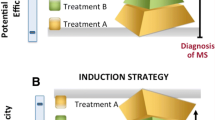Abstract
No effective treatment is presently available for progressive multiple sclerosis (MS). Cyclophosphamide (CFX), a cytotoxic immunosuppressive drug widely used in systemic dysimmune diseases, has been proposed for the treatment of multiple sclerosis with different schedules and controversial results. To evaluate the safety and clinical efficacy of CFX, we compared three different treatment schedules in patients with progressive MS: induction followed by bimonthly boosters for one year (17 patients); bimonthly boosters for one year without previous induction (15 patients); and monthly boosters for one year (21 patients). Survival analysis showed that the percentage of stable patients was significantly higher in the first and third treatment schedule groups. Myelotoxicity occurred in patients treated with induction and boosters (Group A). A high incidence of broncopneumonia was observed in patients undergoing the second treatment schedule (Group B). No major effects were observed in patients treated with monthly boosters (Group C). Response to treatment was limited to secondary progressive form. This study suggests that monthly treatment with CFX might be safely administered in progressive MS patients; its clinical efficacy must be confirmed by an appropriately designed clinical trial.
Sommario
A tutt’oggi non esiste un trattamento di prorata efficacia per la fase progressiva della sclerosi multipla (SM). La ciclofosfamide, un farmaco citotossico da anni utilizzato nel trattamento di patologie disimmuni sistemiche, è stato più volte adoperato impiegando diversi schemi di trattamento e ottenendo risultati differenti. Per valutare l’efficacia clinica e la tollerabilità di questo farmaco, abbiamo confrontato tre diversi schemi di trattamento: A) induzione seguita da boli bimensili per un anno (17 pazienti); B) boli bimensili per un anno non preceduti da induzione (15 pazienti); C) boli mensili per un anno (21 pazienti). La percentuale di malati stabili, analizzata mediante curva di sopravvivenza, è risultata significativamente più elevata nel primo e nel terzo gruppo. Nei pazienti trattati con lo schema A è stata perd osservata un’ alta incidenza di mielotossicità, tra i pazienti trattati secondo lo schema B vi sono stati diversi casi di broncopolmonite, mentre non sono stati rilevati effetti collaterali seri nel gruppo trattato con lo schema C. Il trattamento è risultato efficace solo nei malati con SM progressiva secondaria. Lo studio suggerisce che la ciclofosfamide può essere ben tollerata dai pazienti con SM: l’efficacia clinica del farmaco deve però essere confermata da uno studio disegnato per questo scopo.
Similar content being viewed by others
References
Aimard G, Girard PF, Raveau J (1966) Sclérose en plaques et processus d’autoimmunisation. Traitment par les anti-mitotiques. Lyon Med 215:345–352
Girard PF, Aimard G, Pellet H (1967) Immunodepressive therapy in neurology. Presse Med 75:967–968
Hommes OR, Prick JJG, Lamers KJB (1975) Treatment of the chronic progressive form of multiple sclerosis with a combination of cyclophosphamide and prednisone. Clin Neurol Neurosurg 78:59–62
Hommes OR, Lamers KJB, Reckers P (1980) Effect of intensive immunosuppression on the course of chronic progressive multiple sclerosis. J Neurol 23:177–190
Hauser SL, Dawson DM, Lehrich JR et al (1983) Intensive immunosuppression in progressive multiple sclerosis. N Eng J Med 308:173–180
Likosky WH, Fireman B, Elmore R et al (1991) Intense immunosuppression in chronic progressive MS: The Kaiser study. J Neurol Neurosurg Psychiatry 54:1055–1060
The Canadian Cooperative Multiple Sclerosis Study Group (1991) The Canadian cooperative trial of cyclophosphamide and plasma exchange in progressive multiple sclerosis. Lancet 337:441–446
Goodkin DE, Plencner S, Palmer-Saxerud J et al (1987) Cyclophosphamide in chronic progressive multiple sclerosis. Maintenance vs nonmaintenance therapy. Arch Neurol 44:823–827
Weiner HL, Mackin GA, Orav EJ, Hafler DA, Dawson DM, La Pierre Y, Herndon, R, Lehrich JR, Hauser SL, Turel A, Fisher M, Birnbaum G, McArthur J, Butler R, Moore M, Sigsbee B, Safran A & The Northeast Cooperative Multiple Sclerosis Treatment Group (1993) Intermittent cyclophosphamide pulse therapy in progressive multiple sclerosis. Neurology 43:910–918
Dinant HS, Decker JD, Klippel JH et al (1982) Alternative mode of cyclophosphamide and azathioprine therapy in lupus nephritis. Ann Intern Med 96:728–736
Mc Cune J, Golbus WJ, Zeldes W et al (1988) Clinical and immunological effects of monthly administration of intravenous cyclophosphamide in severe systemic lupus erythematous. N Engl J Med 318:1423–1431
Huston DB, White MS, Bressler RB et al (1983) Immunosuppression for multiple sclerosis. N Engl J Med 309 (4):240–241
Witte T, Schaumann D, Hein R et al (1993) Cyclophosphamidbolustherapie bei Lupus Nephritis, Dtsch Med Wochenschr 118:1005–1010
Killian JM, Bressler RB, Armstrong RM et al (1988) Controlled pilot trial of monthly intravenous cyclophosphamide in multiple sclerosis. Arch Neurol 45:27–30
Mc Donald WI, Halliday AM (1977) Diagnosis and classification of multiple sclerosis. Br Med Bull 33:4–8
Kurtzke JF (1983) Rating neurological impairment in multiple sclerosis: An expanded disability status scale (EDSS). Neurology 33:1444–1452
Carter JL, Hafler DA, Dawson DM et al (1988) Immunosuppression with high-dose IV cyclophosphamide and ACTH in progressive multiple sclerosis: Cumulative 6-year experience in 164 patients. Neurology 38 (Suppl. 2):9–14
Noseworthy JH. Ebers GC, Roberts R (1994) Cyclophosphamide and MS. Neurology 44:579–581
Goodkin DE, Hertsgaard D, Rudck RA (1989) Exacerbation rates and adherence to disease type in prospectively followed-up population with multiple sclerosis. Implication for clinical trials. Arch Neurol 46:1107–1112
Fraiser LH, Kanekal S, Kehrer JP (1991) Cyclophosphamide toxicity. Characteristics and avoiding the problems. Drugs 42 (5):781–795
Author information
Authors and Affiliations
Rights and permissions
About this article
Cite this article
La Mantia, L., Eoli, M., Salmaggi, A. et al. Cyclophosphamide in chronic progressive multiple sclerosis: a comparative study. Ital J Neuro Sci 19, 32–36 (1998). https://doi.org/10.1007/BF03028809
Received:
Accepted:
Issue Date:
DOI: https://doi.org/10.1007/BF03028809




